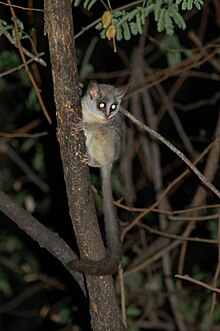Lori-like
| Lori-like | ||||||||||||
|---|---|---|---|---|---|---|---|---|---|---|---|---|

Red slender lory ( Loris tardigradus ) |
||||||||||||
| Systematics | ||||||||||||
|
||||||||||||
| Scientific name | ||||||||||||
| Lorisiformes | ||||||||||||
| Gregory , 1915 |

The Lori-like (Lorisiformes) are a suborder of the primates . They combine the two families of the Loris and Galagos and together with the lemurs form the group of wet-nosed monkeys .
features
Lorikeets are relatively small primates. They reach a head body length of 7 to 40 centimeters, the tail is only a short stub in the Loris, in the Galagos it can be longer than the body. The weight of these animals varies from 0.05 to 2 kilograms. The fur is kept in inconspicuous gray or brown tones, the underside is usually a little lighter. In the construction of the musculoskeletal system, there are clear specifications for the respective way of life: As slow climbers, the Loris have almost the same length of front and rear legs, the hands are transformed into "gripping pincers". In the case of the Galagos, on the other hand, the hind legs and the tarsus are greatly elongated as adaptations to jumping locomotion. As with all wet-nosed monkeys, all fingers and toes have fingernails with the exception of the cleaning claw on the second toe. The head is rounded, the eyes are relatively large. As with all wet-nosed monkeys, the nose is equipped with a nasal mirror . The tooth formula is I 2 / 2- C 1 / 1- P 3 / 3- M 3/3, so a total of 36 teeth. As with most wet-nosed monkeys, the lower incisors and canines form a forward-facing tooth comb .
distribution and habitat
The lories are native to central and southern Africa - but not to Madagascar - and to southern and southeastern Asia , with the Galagos being restricted to Africa, but the lories being found on both continents. The habitat of these animals are forests and other tree-lined areas; in addition to distinct rainforest inhabitants, there are also representatives who live in dry forests or savannas.
Way of life
Both groups of the Lori-like are nocturnal tree dwellers, otherwise the ways of life of the families differ significantly. Galagos move quickly by climbing and jumping and communicate with screams. The Loris, on the other hand, lead a deliberate, hidden way of life: they climb slowly through the branches and hardly make any sounds.
The diet of the Lori-like is variable: in addition to species that feed on fruits or tree sap, there are also omnivorous and some mainly carnivorous representatives. The composition of the diet not only varies between species, there can also be significant differences in diet within a species, depending on the habitat or season.
Systematics
The sister group of the Lori-like are the lemurs , together they form the group of the wet-nosed monkeys . Although the monophyly of the Lori-like and the sister group relationship to the lemurs is relatively certain based on genetic data, there are only a few synapomorphies , i.e. morphological features that clearly distinguish them from the lemurs. These include the structure of the ear region and the blood supply to the skull - in contrast to most lemurs , the internal carotid artery is regressed in the Lori-like species.
The internal system has not been completely clarified. A total of almost 30 species are distinguished. The following list shows the system down to the genre level (according to Wilson & Reeder, 2005):
-
Galagos (Galagonidae)
- Common Galagos ( Galago ): 4 species
- Dwarf galagos ( Galagoides ): 8 species
- Giant Galagos ( Otolemur ): 3 species
- Kielnagelgalagos ( Euoticus ): 2 species
- Squirrel Galagos ( Sciurocheirus ): 4 species
-
Loris (Lorisidae)
- Wrong Potto ( Pseudopotto martini ): Controversial status
- Bear lemurs ( Arctocebus ): 2 species
- Pottos ( Perodicticus ): 3 species
- Schlankloris ( Loris ): 2 species
- Slow loris ( Nycticebus ): 8 species
literature
- Thomas Geissmann : Comparative Primatology. Springer-Verlag, Berlin et al. 2002, ISBN 3-540-43645-6 .
- Don E. Wilson , DeeAnn M. Reeder (Eds.): Mammal Species of the World . A taxonomic and geographic Reference. Johns Hopkins University Press, Baltimore MD 2005, ISBN 0-8018-8221-4 .